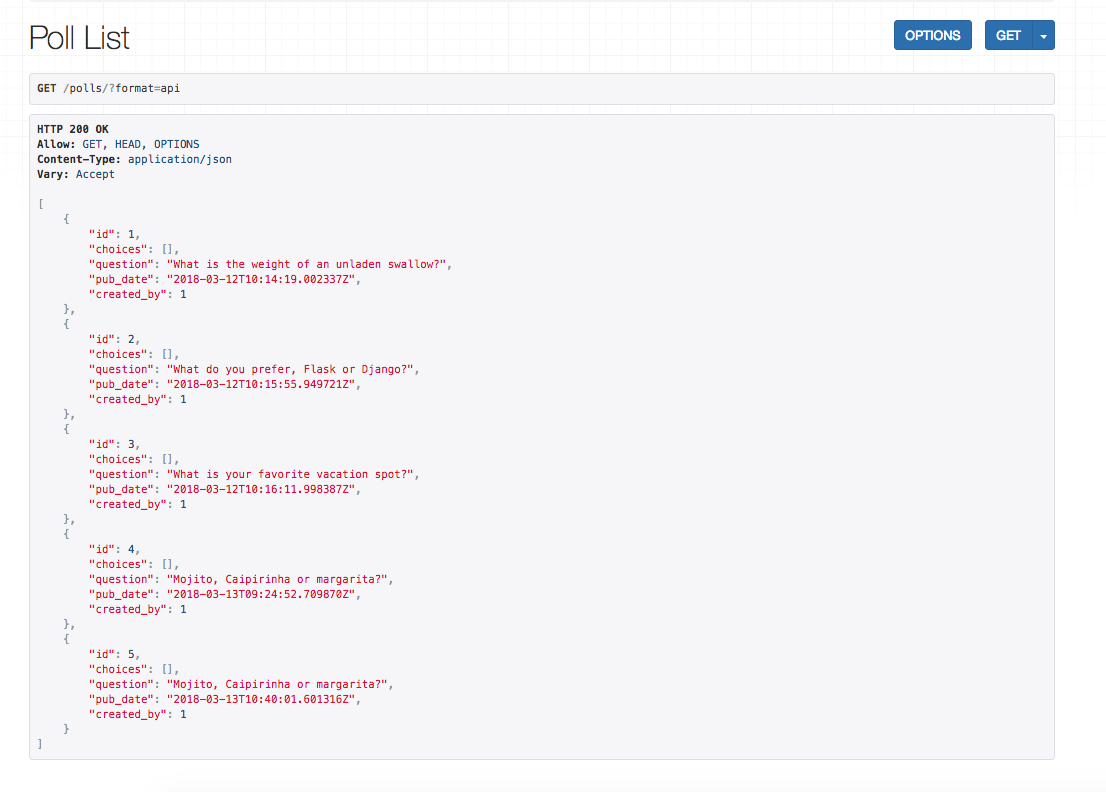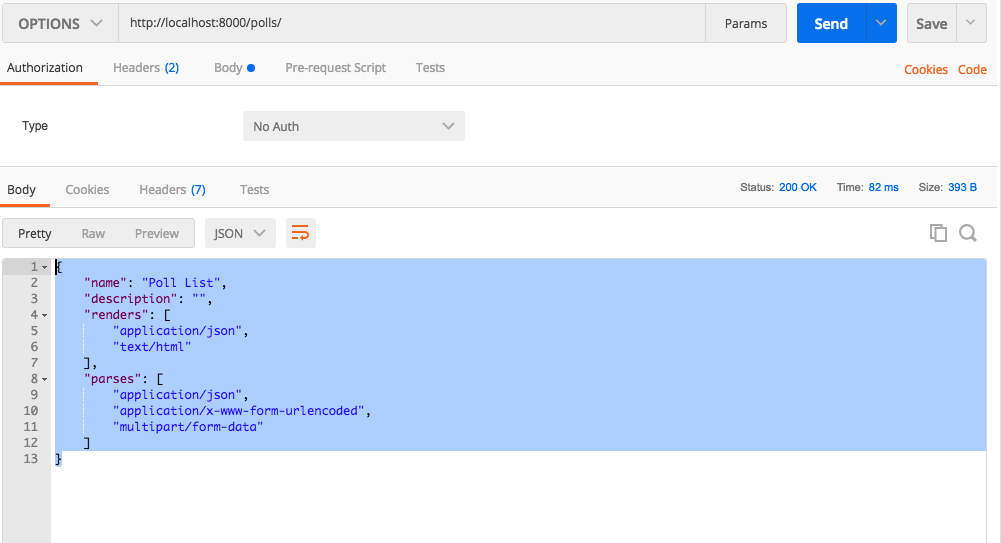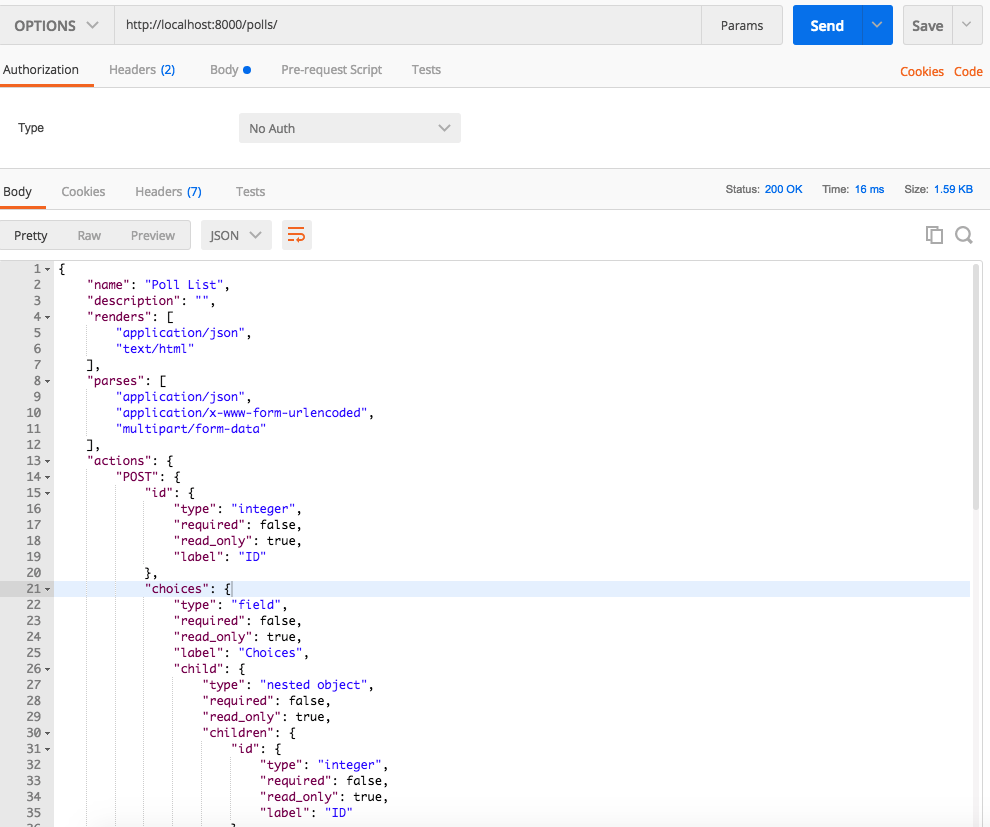Views and Generic Views¶
In this chapter, we will create views using APIVIew, and generics.ListCreateAPIView and family.
Creating Views with APIView¶
To start with, we will use the APIView to build the polls list and poll detail API we built in the chapter, A simple API with pure Django.
Add this to a new file polls/apiviews.py
from rest_framework.views import APIView
from rest_framework.response import Response
from django.shortcuts import get_object_or_404
from .models import Poll, Choice
from .serializers import PollSerializer
class PollList(APIView):
def get(self, request):
polls = Poll.objects.all()[:20]
data = PollSerializer(polls, many=True).data
return Response(data)
class PollDetail(APIView):
def get(self, request, pk):
poll = get_object_or_404(Poll, pk=pk)
data = PollSerializer(poll).data
return Response(data)
And change your urls.py to
from django.urls import path
from .apiviews import PollList, PollDetail
urlpatterns = [
path("polls/", PollList.as_view(), name="polls_list"),
path("polls/<int:pk>/", PollDetail.as_view(), name="polls_detail")
]
DRF comes with a browsable api, so you can directly open http://localhost:8000/polls/ in the browser. It looks like this

You can now do an options request to /polls/, which gives
{
"name": "Poll List",
"description": "",
"renders": [
"application/json",
"text/html"
],
"parses": [
"application/json",
"application/x-www-form-urlencoded",
"multipart/form-data"
]
}
This is how it looks like in postman.

Using DRF generic views to simplify code¶
The PollList and PollDetail get the work done, but there are bunch of common operations, we can do it in abstract away.
The generic views of Django Rest Framework help us in code reusablity. They infer the response format and allowed methods from the serializer class and base class.
Change your apiviews.py to the below code, and leave urls.py as is.
from rest_framework import generics
from .models import Poll, Choice
from .serializers import PollSerializer, ChoiceSerializer,\
VoteSerializer
class PollList(generics.ListCreateAPIView):
queryset = Poll.objects.all()
serializer_class = PollSerializer
class PollDetail(generics.RetrieveDestroyAPIView):
queryset = Poll.objects.all()
serializer_class = PollSerializer
With this change, GET requests to /polls/ and /polls/<pk>/, continue to work as was, but we have a more data available with OPTIONS.
Do an OPTIONs request to /polls/, and you will get a response like this.
{
"name": "Poll List",
"description": "",
"renders": [
"application/json",
"text/html"
],
"parses": [
"application/json",
"application/x-www-form-urlencoded",
"multipart/form-data"
],
"actions": {
"POST": {
"id": {
"type": "integer",
"required": false,
"read_only": true,
"label": "ID"
},
// ...
},
"question": {
"type": "string",
"required": true,
"read_only": false,
"label": "Question",
"max_length": 100
},
"pub_date": {
"type": "datetime",
"required": false,
"read_only": true,
"label": "Pub date"
},
"created_by": {
"type": "field",
"required": true,
"read_only": false,
"label": "Created by"
}
}
}
}
This tells us
- Our API now accepts POST
- The required data fields
- The type of each data field.
Pretty nifty! This is what it looks like in Postman.

More generic views¶
Let us add the view to create choices and for voting. We will look more closely at this code shortly.
from rest_framework import generics
from .models import Poll, Choice
from .serializers import PollSerializer, ChoiceSerializer, VoteSerializer
class PollList(generics.ListCreateAPIView):
queryset = Poll.objects.all()
serializer_class = PollSerializer
class PollDetail(generics.RetrieveDestroyAPIView):
queryset = Poll.objects.all()
serializer_class = PollSerializer
class ChoiceList(generics.ListCreateAPIView):
queryset = Choice.objects.all()
serializer_class = ChoiceSerializer
class CreateVote(generics.CreateAPIView):
serializer_class = VoteSerializer
Connect the new apiviews to urls.py.
# ...
from .apiviews import ChoiceList, CreateVote, # ...
urlpatterns = [
# ...
path("choices/", ChoiceList.as_view(), name="choice_list"),
path("vote/", CreateVote.as_view(), name="create_vote"),
]
There is a lot going on here, let us look at the attributes we need to override or set.
queryset: This determines the initial queryset. The queryset can be further filtered, sliced or ordered by the view.serializer_class: This will be used for validating and deserializing the input and for serializing the output.
We have used three different classes from rest_framework.generic. The names of the classes are representative of what they do, but lets quickly look at them.
ListCreateAPIView: Get a list of entities, or create them. Allows GET and POST.RetrieveDestroyAPIView: Retrieve an individual entity details, or delete the entity. Allows GET and DELETE.CreateAPIView: Allows creating entities, but not listing them. Allows POST.
Create some choices by POSTing to /choices/.
{
"choice_text": "Flask",
"poll": 2
}
The response looks like this
{
"id": 4,
"votes": [],
"choice_text": "Flask",
"poll": 2
}
You can also retrieve the Poll to by doing a GET to /polls/<pk>/. You should get something like this
{
"id": 2,
"choices": [
{
"id": 3,
"votes": [],
"choice_text": "Django",
"poll": 2
},
{
"id": 4,
"votes": [],
"choice_text": "Flask",
"poll": 2
}
],
"question": "What do you prefer, Flask or Django?",
"pub_date": "2018-03-12T10:15:55.949721Z",
"created_by": 1
}
If you make a mistake while POSTing, the API will warn you. POST a json with choice_text missing to /choices/.
{
"poll": 2
}
You will get a response like this
{
"choice_text": [
"This field is required."
]
}
Check the status code is 400 Bad Request.
Next Steps¶
We have working API at this point, but we can simplify our API with a better URL design and remove some code duplication using viewsets. We will be doing that in the next chapter.